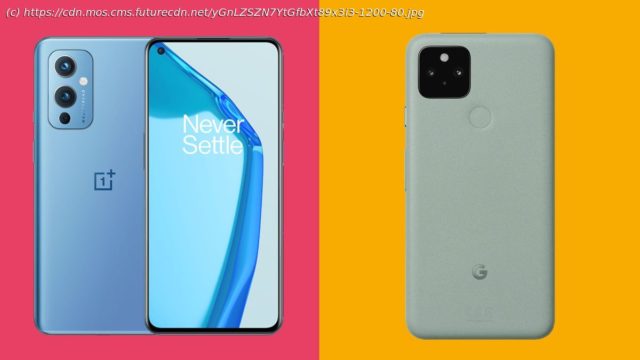How do you build a more affordable flagship? The OnePlus 9 and the Pixel 5 have compelling but differing solutions
If you like your smartphones to be solidly built, with super-clean software and strong cameras for around the $700 / £600 mark, then only two phones come to mind. The Google Pixel 5 and the OnePlus 9 are two of the finest upper-mid-range phones out there, with each packing impressive specifications for a good deal less money than the true flagship brigade. But which of the two is best? A glance at our respective reviews would suggest the OnePlus has the advantage, having scored 9 out of 10 to the Pixel 5’s 8 out of 10. But it isn’t quite as simple as that. Both of these phones are available to buy right now, with the Pixel 5 having launched on October 15,2020, and the OnePlus 9 hitting shops on March 26, 2021. Prices for the OnePlus 9 start from $729/£629 for 8GB of RAM and 128GB of storage, while a move up to $829/£729 will get you 12GB of RAM and 256GB of storage. The Google Pixel 5 continues to sell at its launch price of $699 / £599 / AU$999 from the official Google Store, but you may be able to find a deal given its relative age. We love both of these phones, but neither is what we’d call a looker. Indeed, there’s an argument to be made that both the OnePlus 9 and the Google Pixel 5 represent regressions in terms of design. The OnePlus 8 and the Pixel 4 before them packed in elements that could be considered more premium. Still, we’d probably give the Google Pixel 5 the edge for its brave normcore-chic approach. Its all-metal body stands out among the usual glass sandwich brigade, while a curious matte material finish (in Sorta Sage and Just Black) adds to a general feeling of grip and ruggedness. A completely flat display and a rear-mounted fingerprint sensor (which isn’t particularly fast or responsive) completes this workmanlike air. But, despite all this, you wouldn’t confuse the Pixel 5 for any other (non-Google) phone. You can’t say the same for the OnePlus 9. It’s similarly undemonstrative – or “burdenless”, to use the OnePlus parlance – with the same kind of flat display and hole punch selfie camera. But it’s also rather more generic in its emulation of more expensive phones, and it even feels a little cheap. Unlike Google, OnePlus has run away from any use of metal, opting instead for a fiberglass-reinforced polymer frame. Or shiny plastic, if you want to simplify things. The back is glass, however, and you get one more color option with the OnePlus 9: Winter Mist, Arctic Sky, and Astral Black. Another point in favor of the Pixel 5 – at least for some – will be its compact dimensions. At 160 x 74.2 x 8.7mm and 192g, the OnePlus 9 dwarfs the Pixel 5 at a mere 144.7 x 70.4 x 8mm and 151g. We do like the OnePlus 9’s trademark alert slider though, which provides effortless access to silent and vibrate modes. Google could do worse than adopt something similar. If Google takes a narrow lead with the design of its Pixel 5, then the OnePlus 9 draws even with a slightly superior display. While both phones use FHD+ OLED screens, the OnePlus 9’s panel is bigger and brighter. At 6.55 inches, it offers a fair amount of extra real estate over the 6-inch Pixel, and a 1,100 peak brightness goes well beyond the 700-odd at which the Pixel 5 has been recorded. The OnePlus 9’s screen is also more fluid, with a maximum refresh rate of 120Hz. Google’s phone can only manage 90Hz. That’s far from a disgrace – Apple is still stuck at 60Hz – but the advantage is quite clear. Still, neither display uses LTPO technology for a truly variable refresh rate, so the Pixel 5 display is likely to be the more energy efficient of the two.
Home
United States
USA — software OnePlus 9 vs Google Pixel 5: competing with top smartphones in very...






